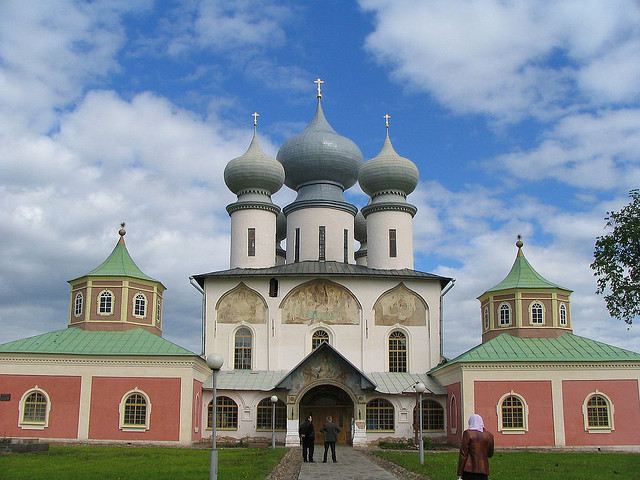

Location: Tichvin
Found: 11th February, 1570 by Pimen


Tichvinsky Uspensky Monastery is a Russian Orthodox monastery located in Tichvin in Leningrad Oblast in North part of European Russia. It was found on 11th February, 1570 by brother Pimen. It is home to one of the most venerated icons in Russia, Tichvin Mother of God.
It was founded by decree of Ivan the Terrible on February 10, 1560 by
the Novgorod archbishop Pimen. The management of the work was entrusted
to the Novgorod builder Fyodor Syrkov (executed by Ivan the Terrible
during the oprichnina pogrom of Novgorod). The timing of construction
was given special importance, so the tsar allowed the use of peasants
from twenty volosts for all types of work.
The main relic of the
monastery is the miraculous Tikhvin Icon of the Mother of God
Hodegetria. During religious processions, however, a remote icon was
used in the monastery. According to legend, for 200 years she was in
Staraya Russa in the Spaso-Preobrazhensky Monastery (or in the
Resurrection Cathedral of the city), but was transferred to Tikhvin.
Allegedly, during the pestilence in Staraya Russa and Tikhvin, a certain
"reverent man" had a vision from above that the disaster would end if
the icons of the Mother of God in Staraya Russa and Tikhvin were
reversed. After that, the copy of the Tikhvin Icon was brought to
Staraya Russa, and the Old Russian Icon to Tikhvin; shortly thereafter,
the pestilence, according to tradition, ceased.
According to
legend, on one of the places of her miraculous appearance, a temple was
founded by believers in 1383. After the icon descended into the hands of
those who prayed to it on the banks of the Tikhvinka, the construction
of the Church of the Assumption of the Most Holy Theotokos began there
immediately on the same day. However, the next day, the foundation
already set disappeared along with the icon and appeared on the other
side of the river. After that, the Mother of God, accompanied by
Nicholas the Wonderworker, appeared to the sexton George, who was sent
to inform the neighborhood about the approaching consecration of the
temple, and ordered to put a wooden, not iron, cross on the temple. At
the place of its appearance, a chapel was erected in the name of St.
Nicholas.
In 1390, the wooden chapel and temple burned down, but
the icon and the wooden cross, according to legend, remained unharmed.
In 1395, the restored chapel and temple burned down again. The third
time a fire destroyed the church in 1500, the icon was saved by priest
Vasily and his son Stefan. It was replaced by a new wooden one, but in
1510 Vasily III ordered the construction of a stone church in its place
- it was consecrated on August 12, 1515. At the same time, on the site
of the appearance of the Virgin to sexton George, the small Nikolaev
Conversational Monastery was founded, which still existed in 1859.
In 1613, the monastery was besieged by the Swedish army led by Jacob
Delagardie, but its defenders, led by Prince Semyon Prozorovsky, were
able to repel several assaults and hold the monastery until
reinforcements arrived. In 1623, the Assumption Cathedral of the
monastery was damaged in a fire, but it was renovated by 1624. At the
same time, a new iconostasis was built in the cathedral, which was
finished with pure gold in 1794.
In 1747, Empress Elizaveta
Petrovna ordered to build a stone fence around the monastery. Its
construction began in 1766, and in 1788 the western part was completed.
In 1795, the construction of the eastern, northern and southern parts
was completed. For this, donations from Emperors Paul I and Alexander I
(37,000 rubles) and the monastery's own funds (about 20,000 rubles) were
used. The total length of the fence reached 450 fathoms.
The
illustrated (front) manuscript of the “Tales of the Tikhvin Icon of the
Mother of God” of the first half of the 18th century, kept in the
Russian National Library, presents a unique miniature depicting the
Tikhvin Assumption Monastery, which is a valuable source on its
architectural history.
In 1854, a cross was delivered for the
vestry of the monastery, the work of the St. Petersburg master F. A.
Verkhovtsev.
In the 20th century
In the 1920s, the temples of
the monastery were transferred to the Renovationists, in the 1930s they
were closed, and the icon, which was considered miraculous, became an
exhibit of the local museum of local lore.
During the Great
Patriotic War, the city was occupied by German troops for a short time,
but during the retreat they took the icon to Pskov, where they handed it
over to the Orthodox spiritual mission, then the icon ended up in Riga,
Libau, Yablonets, the American occupation zone in Germany, from there
Bishop John (Garklavs) took her to Chicago (USA). Dying, Bishop John
left a will, according to which the return of the shrine to Russia is
possible only with the complete revival of the Tikhvin Monastery.
In 1945, the Church of the Tikhvin Icon of the Mother of God “The
Porch”, which was built according to the design of Nikolai Benois and
consecrated in 1863, located in the western tower of the monastery
fence, was provided for use by the Orthodox community (for more than 40
years it was the only temple in operation on the territory of the
Tikhvin and Boksitogorsk regions) .